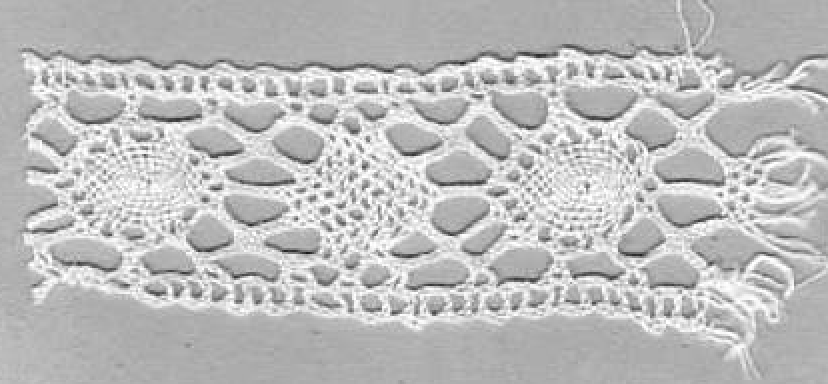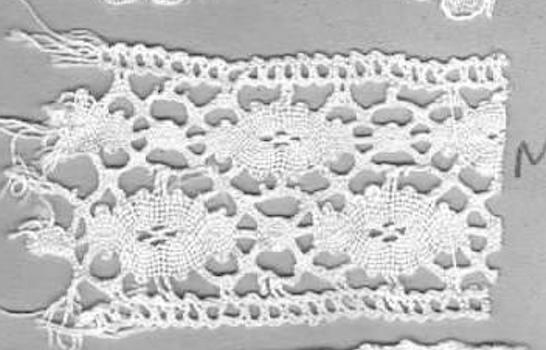Fabric

Buying modern fabric to look historically accurate can be a challenge. Some fabrics - especially some silks - can be very costly to the individual too. Using the knowledge of our costuming experts within the group, we have put together a few guides and references to various aspects of modern fabric and how to make them work for regency costumes. The Hampshire Regency Dancers also have a fabric swatch book, available to members for reference during a Wednesday session.
Fabric Colours
A very useful guide into the colours used in the Regency and Georgian eras can be found here at Renaissance and Regency Rummage Repository.
Which lace will do?
We have provided here some photo samples of different types of lace, and with guidance from one of our members Kate Lobb, have given some direction on which will look right for historically accurate regency attire and if so, what they can be used for.
Fabric terminology
- Batiste
- Very fine fabric of mixed silk and wool
- Brocade
- See Damask - the pattern produced is not reversible
- Calico
- Narrow and coarse cotton fabric made from cheap grade cotton and highly sized
- Cambric
- Thin, narrow, stiff glazed cotton made from poorer yarns - always sized and has a high polish - it does not launder - used for linings and pattern modelling.
- Canvas
- Rough heavy fabric woven of flax, cotton and sometimes jute - better grades can be used for interlinings
- Cashmere
- Fabric woven from the wool of the Kashmere or Pashmina goat. Introduction in the Regency began with soldiers bringing back examples of shawls and supply grew through the East India Company.
- Corduroy
- Fabric with distinctive raised cord derived from cutting loops on fustian fabric
- Cotton
- A versatile natural fibre derived from the bolls of fine cellulose strands around the seeds of the cotton plant - can be woven into many fabric styles - see other definitions.
- Damask
- A weaving process with one warp yarn and one weft yarn usually with the pattern in warp faced satin weave and the background in weft faced satin weave, which yields a reversible pattern.
- Denim
- Sturdy cotton warp-faced fabric in which the weft passes under two or more warp threads producing a fine diagonal ribbing which distinguishes it from Duck
- Drill
- Stout twilled cotton - light drill is called Jean
- Duck
- Heavy plain woven cotton or linen fabric used in shoes and workwear
- Flannel
- Soft fabric of wool or cotton - can be brushed to raise the fibres to form a nap
- Fustian
- Thick hard wearing cloth with a short nap woven from cotton or possibly mixed with linen, usually dyed in dark colours and used for artisan clothing. Often having a pile face and twill weave.
- Gauze
- A weave in which the warp yarns, instead of being parallel, twist round each other and are held by the filling so as to make an open lacy effect.
- Jean
- A light cotton drill
- Jersey
- A woolen or silk mixed stockingette weave
- Lawn
- Thin light cotton usually sized and highly polished. May have soft or stiff finish. Fine lawn may take the place of organdie
- Mercerised
- A chemical process used on cotton - makes cotton thread more lustrous, stronger and able to accept dye better.
- Merino
- Fine, smooth and soft wool highly prized. The Spanish sheep from which it is derived does not suit the British climate and so cloth had to be imported.
- Moire
- Watered fabric obtained by passing it through engraved rollers producing a crushed watermark
- Muslin
- Light and very sheer cotton (very different from modern muslin)
- Net
- Open mesh fabric with holes larger than Tulle
- Organdy
- Crisp transparent fabric finish made from cotton.
- Poplin
- Fabric with a cord effect across the cloth which may be combined with damask twill, brocade and other fancy weaves
- Satin
- Warp or weft surface cloth in which the intersections of warp and weft are so arranged to be imperceptible - smooth
- Sateen
- Cloth with broken twill or satin weave - an imitation of satin in cotton or wool
- Silesia
- Coarse linen cloth woven on a wide setting, a cotton imitation of the linen cloth for linings
- Slubs
- Small lumps appearing in cheaper silks due to variation in the quality of the thread
- Stockinette
- A soft, loosely knitted stretch fabric made of cotton formerly used for making underwear (now used for cleaning, wrapping or bandaging)
- Taffeta
- Silk with a smooth surface and crisp feel
- Tulle
- A form of netting that is made of small-gauge thread, netted in a hexagonal pattern with small openings, and frequently starched to provide body or stiffness. It is a finer textile than the textile referred to as "net."
- Twill
- A fundamental weave - the intersection of yarns forms lines running to right or left diagonally across the fabric.
- Velvet
- Soft thick fabric with a felted face and plain underside - made from silk in the regency period
- Voile
- Open cloth of a canvas type made with plain weave interlining and hard twist cotton or worsted yarn.














